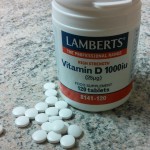 Evidence shows that plasma concentrations of the vitamin D marker 25-hydroxyvitamin D [25(OH)D] are inversely associated with adiposity. However the nature of this association between vitamin D and obesity is not fully understood because it is not clear if higher levels of 25(OH)D can cause improvements in body composition. Therefore although there is an association, determining the cause and effect is difficult. For example, it is unclear whether increased vitamin D intake causes reductions in adiposity, or if excess adipose tissue reduces circulating levels of vitamin D. If adipose tissue is the causative factor in the association between vitamin D and obesity, it could be that adipose tissue sequesters the vitamin, lowering plasma levels. Obese individuals do have the capacity to maintain plasma levels of vitamin D for longer compared to lean individuals, but also take longer to accumulate the vitamin in their plasma. Therefore adipose tissue may act as a store of the vitamin, releasing and absorbing it as plasma levels change.
Evidence shows that plasma concentrations of the vitamin D marker 25-hydroxyvitamin D [25(OH)D] are inversely associated with adiposity. However the nature of this association between vitamin D and obesity is not fully understood because it is not clear if higher levels of 25(OH)D can cause improvements in body composition. Therefore although there is an association, determining the cause and effect is difficult. For example, it is unclear whether increased vitamin D intake causes reductions in adiposity, or if excess adipose tissue reduces circulating levels of vitamin D. If adipose tissue is the causative factor in the association between vitamin D and obesity, it could be that adipose tissue sequesters the vitamin, lowering plasma levels. Obese individuals do have the capacity to maintain plasma levels of vitamin D for longer compared to lean individuals, but also take longer to accumulate the vitamin in their plasma. Therefore adipose tissue may act as a store of the vitamin, releasing and absorbing it as plasma levels change.
Other explanations for the association between obesity and vitamin D concentrations have been suggested. For example, adipose tissue has a high expression of 24-hydroxylase, an enzyme that catalyses the breakdown of vitamin D. Increases in adipose tissue may therefore accelerate the degradation of the active form of the vitamin. Alternatively, the non-alcoholic fatty liver associated with obesity may decrease hydroxylation of vitamin D to 25(OH)D in hepatic tissue. If the vitamin D is the causative factor and higher plasma levels cause reductions in body fat, there are possible explanations for this scenario too. One mechanism that may allow 25(OH)D to affect body fat is through increases in plasma calcium levels, which may in turn lower cellular calcium and increase insulin sensitivity. However, such a mechanism, termed the calcium paradox, is controversial and is not fully understood. Because calcium is also associated with lower body weights, it is tempting to speculate that vitamin D causes weight loss through calcium regulations.
